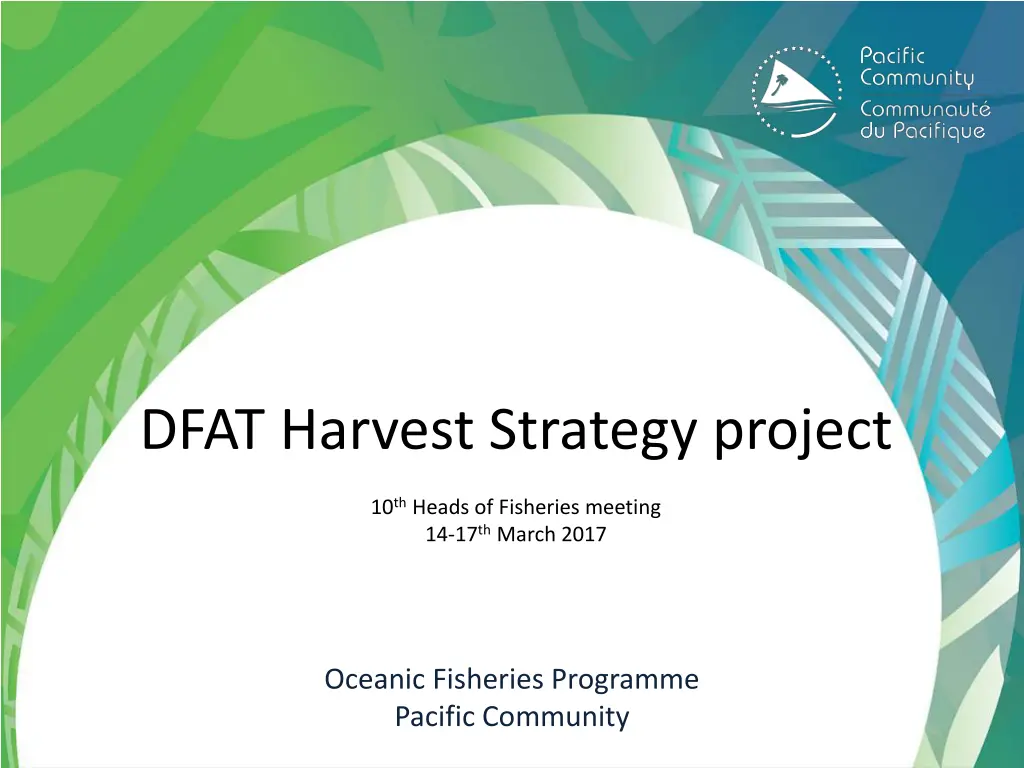
Harvest Strategies for Sustainable Pacific Fisheries
Explore the DFAT Harvest Strategy Project focusing on developing harvest strategies for key fisheries in the Pacific Community. Learn about the aims, background, and approach to enhancing science and member capacity for sustainable fisheries management. Dive into elements like target reference points, management objectives, and the need for testing alternative strategies through Management Strategy Evaluation (MSE).
Download Presentation

Please find below an Image/Link to download the presentation.
The content on the website is provided AS IS for your information and personal use only. It may not be sold, licensed, or shared on other websites without obtaining consent from the author. If you encounter any issues during the download, it is possible that the publisher has removed the file from their server.
You are allowed to download the files provided on this website for personal or commercial use, subject to the condition that they are used lawfully. All files are the property of their respective owners.
The content on the website is provided AS IS for your information and personal use only. It may not be sold, licensed, or shared on other websites without obtaining consent from the author.
E N D
Presentation Transcript
DFAT Harvest Strategy project 10thHeads of Fisheries meeting 14-17thMarch 2017 Oceanic Fisheries Programme Pacific Community
Contents Background What are harvest strategies? Aims of the project Project structure
Background Key driver: Regional Roadmap for Sustainable Pacific Fisheries, and associated Report Cards Western and Central Pacific Fisheries Commission (WCPFC) 12thmeeting: agreed a work plan to develop harvest strategies for key stocks and fisheries Marine Stewardship Council certifications E.g. PNA free school South Pacific albacore longline
What are Harvest Strategies? Elements of a Harvest Strategy LRP TRP Management Objectives What do you want from your fishery? Reference Points and Risk Levels Where do you want to be? (targets) Where do you NOT want to be? (limits) How much do you not want to be there? (risk) Harvest Control Rules Management Strategy Evaluation Testing the HCRs and choosing the best Monitoring Strategy Is the HCR performing as you would expect? Effort/ Catch Biomass
What are Harvest Strategies? NOT just science! Member driven exercise Target reference points (where you want to be) Limit reference points (where not to go) Multispecies considerations Performance Measures (How are we doing?) Management Objectives
Approach Need to test alternative harvest strategies In particular harvest control rules Do rules achieve objectives of managers/stakeholders? Are they robust to uncertainty ? What are the trade-offs between different HCRs? Do this through simulation testing Requires a modelling framework to do this = Management Strategy Evaluation (MSE)
Aims of the project Still to receive final approval from NZ Provide support to SPC and FFA to enhance science and member capacity for harvest strategy development Also engage fishing nations in the process, through WCPFC
Improved regional management of oceanic tuna stocks MEDIUM- TERM OUTCOME Tools and capacity to enable informed decision making on management procedures SHORT-TERM OUTCOME 5. 3. 4. TECHNICAL OUTPUTS Monitoring strategy framework Candidate harvest control rules identified Modelling framework for MSE developed 2.1 2.2 ENABLING OUTPUTS Engagement with SPC/FFA/PNA members Engagement with other WCPFC members 1. Stakeholder engagement strategy
Main points Staged approach allow SPC/FFA members to develop harvest strategies that meet objectives Iterative approach to development Secondly, take those options to WCPFC to achieve Commission-wide engagement and adoption Plan: initial focus on skipjack and SP albacore
Output 1 Stakeholder engagement strategy Primarily members but also wider stakeholders. Develop tailored information resources to facilitate information uptake
Outputs 2 Engagement and capacity development with SPC/FFA/PNAO members enhancing capacity and applying the outputs in decision-making on harvest strategy arrangements Subsequently engage other Parties Bring other CCMs and stakeholders up to a level where they can participate in the final decision making processes, such as agreement of compatible measures between high seas and EEZs
Outputs 3 -4 Technical development: Output 3: candidate harvest control rules designed for inclusion in the modelling framework Output 4: Modelling framework developed (computer simulation approach).
Output 5 Monitoring strategy framework: Framework to identify whether things are going to plan in the real world
Support focus Three key technical positions at SPC 2 modellers 1 advisor focussed on engagement strategy Support for FFA fishery advisor engagement
Time Scale : 5 yr project Start date : April 2017?
Improved regional management of oceanic tuna stocks MEDIUM- TERM OUTCOME Tools and capacity to enable informed decision making on management procedures SHORT-TERM OUTCOME 5. 3. 4. TECHNICAL OUTPUTS Monitoring strategy framework Candidate harvest control rules identified Modelling framework for MSE developed 2.1 2.2 ENABLING OUTPUTS Engagement with SPC/FFA/PNA members Engagement with other WCPFC members 1. Stakeholder engagement strategy
